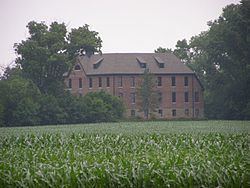Built 1888 Opened 1888 | NRHP Reference # 73000018 Added to NRHP 19 June 1973 | |
 | ||
People also search for Old Main, Native American Resource Center, Deam Lake State Recreation Area | ||
St. Joseph's Indian Normal School's purpose was to educate American Indians. This was believed to be the best way to assimilate them into the white culture. Operating from 1888 to 1896, the U.S. government funded the school's operation. It was believed that this was the best way to "civilize" Native Americans and the western territories. Established by the Catholic Indian Missions with funding from Katharine Drexel, the school taught 60 Indian children. The Society of Precious Blood operated the school during its years of operation. The students were all boys. When the Indian School was closed, the building was named Drexel Hall. It is one of the first structures of St. Joseph's College.
The Indian school was essentially a red brick structure with the ground floor surrounded with a sandstone wall. It was built in a square, 80 feet (24 m) on each side. The square courtyard in the center, it being around 30 feet (9.1 m) on each side. Each wing had four floors with the east wing only three floors high. The roof was red tiles. The main entrance was on the west. It was owned by the Bureau of Catholic Indian Missions in Washington, D.C.
It was a boarding school for Indian boys with space for 70 boys, their classrooms, playroom, dormitory, kitchen, a small chapel, rooms for the superintendent and a teacher or two and for around six Sisters (nuns) who ran the kitchen. An inspector's report said there were 29 rooms in all. Although the building served as an Indian school for only eight years (1888-1896), it was not changed or altered until 1937 when it was re-modeled to serve as a residence hall for Saint Joseph's College. Only the bell tower was removed along with the shutters from the windows. On the inside, it was altered. The courtyard was made smaller to allow an extra row of rooms. The building, called Drexel Hall, currently serves as a student residence on the Saint Joseph's College campus.
Significance
It represents a time when the country hoped to solve the Indian question by off-reservation schools. Here Indian pupils would be assimilated into white man's culture. The boys would then convert their own people when they returned home.
- It was designed in imitation of the Carlisle Indian school of Carlisle, Pa., founded nine years earlier.
- It was a "contract" school, i.e., one of the many private schools once supported by an annual federal per pupil subsidy to promote Indian education, therefore a relic of an era of state-church partnership now largely forgotten.
- It was the only Catholic off-reservation school of this type.
- It was one of only two such Indian schools in the state of Indiana, the other being White's Manual Labor Institute at Wabash, Indiana, also a "contract school” of the Society of Friends.
